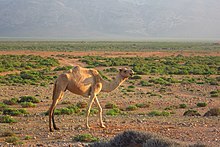Camel urine

| This article is part of a series on |
| Alternative medicine |
|---|
 |
Camel urine is a liquid by-product of metabolism in a
Anatomy
Camel urine comes out as a thick syrup.[2][3][4][5]
The
Each kidney of an
Most food is digested and absorbed into the bloodstream from the small intestine. Any remaining liquids and roughage move into the large intestine.Hadith
A hadith in
Indian Islamic scholar
Usage and research
In Yemen, camel urine is consumed and used for treating ailments, though it has been widely denounced.[13] Some salons are said to use it as a treatment for hair loss.[13] The camel urine from a virgin camel is priced at twenty dollars per liter, with herders saying that it has curative powers. It is traditionally mixed with milk.[13]
Certain preclinical studies have claimed that camel urine possesses various therapeutic advantages, including antimicrobial, anti-inflammatory, and anticancer properties, and even potential cardiovascular benefits. For example, in 2012, a study conducted at the Department of Molecular Oncology of King Faisal Specialist Hospital and Research Center, and published in the Journal of Ethnopharmacology, found that camel urine contains anti-cancerous agents that are cytotoxic against various, but not all, human cancer cell lines in vitro.[21]
A study published on the World Health Organization's Eastern Mediterranean Health Journal found that camel urine showed no clinical benefits in cancer patients, with two of the participants developing brucellosis.[1] Given the lack of scientific evidence supporting the use of camel urine as a traditional medicine, it is advisable to discontinue its promotion.[1]
In 2017, a joint study by King Faisal University and University of Hong Kong found that experimental infections of
See also
References
- ^ a b c Administrator. "Observational study and literature review of the use of camel urine for treatment of cancer patients". World Health Organization - Regional Office for the Eastern Mediterranean. Archived from the original on 2023-06-09. Retrieved 2023-06-08.
- ISBN 978-0192806819.
- ^ "Kidneys and Concentrated Urine". Temperature and Water Relations in Dromedary Camels (Camelus dromedarius). Davidson College. Archived from the original on February 25, 2003.
- ^ "Fun facts about the Camel". The Jungle Store. Archived from the original on 17 November 2012. Retrieved 3 December 2012.
- ^ Fedewa, Jennifer L. (2000). "Camelus bactrianus". Animal Diversity Web. University of Michigan Museum of Zoology. Archived from the original on 26 May 2013. Retrieved 4 December 2012.
- ^ "Morphometric analysis of heart, kidneys and adrenal glands in dromedary camel calves". Journal of Camel Practice and Research. 14 (1): 27. Archived from the original on 2017-03-04. Retrieved 2017-03-03.
- ^ Rehan S and AS Qureshi, 2006. Microscopic evaluation of the heart, kidneys and adrenal glands of one-humped camel calves (Camelus dromedarius) using semi automated image analysis system. J Camel Pract Res. 13(2): 123
- PMID 13044660.
- ISBN 0-87605-606-0.
- Encyclopedia of the Quran
- ^ "Bukhari 76:9". Archived from the original on 2021-07-09. Retrieved 2021-07-08.
- ^ a b Muhammad al-Bukhari. "Sahih al-Bukhari 233". Sunnah.com. Archived from the original on 2020-09-28.
- ^ VICE News. Archivedfrom the original on 28 September 2019. Retrieved 28 September 2019.
- ^ "Error404". Archived from the original on 2022-09-14. Retrieved 2022-09-14.
- , 18 August 2003
- ^ "Bukhari 76:8". Archived from the original on 2021-07-09. Retrieved 2021-07-07.
- ^ The American Journal of Islamic Social Sciences. Jointly published by the Association of Muslim Social Scientists; International Institute of Islamic Thought. 2007. Archived from the original on 2023-10-24. Retrieved 2021-07-05.
- ^ "Sahih Muslim - Book of Oaths, Muharibin, Retaliation, and Blood Money". muflihun.com. Archived from the original on 2021-02-06. Retrieved 2021-02-01.
- ^ "Sahih Muslim 1671a - Book 28, Hadith 12". Archived from the original on 2021-07-09. Retrieved 2021-07-05.
- ^ "An Anthology of Reformative Articles".
- from the original on 2016-07-13. Retrieved 2021-01-23.
- PMID 26256102.
- PMID 25418529.
